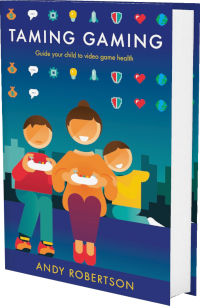 Android
Android iOS
iOS Mac
Mac Switch
Switch Wii
Wii Wii U
Wii U PC
PC PS4
PS4 PS5
PS5 Xbox One
Xbox One Xbox X|S
Xbox X|S02/05/2024 2 weeks ago Author: Andy Robertson
Play is vital to children's development yet under threat. It is the means by which they practise the skills to thrive in adulthood. But for 50 years, children's opportunities for free play have been declining as parental fears, increased homework, automobiles and lonelier neighbourhoods keep them off the streets, out of the fields and behind front doors. And yet, the drive to play remains untamed.
The Shape of Childhood
Teaching young people useful things to prepare them for life in the real world is a high calling. But having left our childhoods behind many years ago, how do we know what to teach that will support them in the world of today?The problem is that we don’t actually leave our childhoods behind. They stay with us, frozen in the form we experienced them. And if we aren’t careful, we prepare children for the world we grew up in. Or we become resistant to the new shape of childhood in favour of sentimentality for how things were for us.
What stretches across generations, linking our memories to the childhoods of today, is the importance and centrality of play. As Play Wales states in its Play Principles:
“all children and young people need to play. It is a biological, psychological and social necessity, and is fundamental to the healthy development and wellbeing of individuals and communities”
The Battle For Playing Out
There’s an upswell of work to consider sufficiency of access to play, and the impact this has on the lives of children. Remembering our childhoods, we recognise the diminishing opportunities and spaces to play outside. Organisations like Bristol-based Playing Out have not only been a rallying point for bringing play back to our streets but have sparked a Government inquiry into children and the built environment.In the battle to bring back play (often in parallel with reclaiming neighbourhoods from the motorcar), we can miss what children themselves are doing to find the play they are lacking. Paying attention to how, where and when children play — and who they are playing with — is an essential way to understand what support, resources, guidance and legislation they need to prepare them for their world.
This is difficult, no more so than when play is digital. Deciphering the activity on the screens of children is time-consuming, confusing and humbling. It doesn’t match the childhood we remember. The childhood that we are fighting to reclaim for them.
The temptation is to find reasons not to do this work. We say that digital play is less than real physical play. Being online is harming children’s mental health. Tech companies are tricking children with dopamine-fuelled tactics. Screen addiction negatively impacts other more important areas of life.
Of course, digital play doesn’t escape risks, commercialisation, abuses or overuse. Big companies make games for children to play that are designed to meet their corporate goals and serve shareholders. Not all games are suitable for all children. Not everyone in online games is there with good intentions.
Digital Play Is Play
However, if we only see harms and dangers we miss the reality that children flock to video games mostly because of how well-fitted these experiences are to the desires and deficits of their childhood. Get your hands dirty in the digital leaf litter of video games like Roblox and Poki, and you put your finger on the pulse of a younger generation. Among the jangling, dissonant and confusing images, sounds and interactions are children who understand the opportunities video games offer.For the past 10 years, I’ve been pursuing this other front in the movement for healthy childhood play. It’s a line of engagement that focuses on what is on the screen, rather than how long the child is at the screen. Rather than aiming to limit, make safe or diminish this digital play, I’ve aimed to understand how it might equip children for the world they are growing up in.
Seeking this understanding is an ongoing exploration. It’s a thousand conversations to hear what Roblox offers a young player. It’s researching two new games every day in the hunt for the solutions children are finding to the social harms they encounter in the world. It’s identifying the similarities between video games and adventure playgrounds.
Back from a tour of duty in the forest of children’s digital play, I want to report that there are exciting opportunities for supporting children who love video games. Alongside movements that established “Playing Out” as an opportunity and habit for children, this understanding of video games needs similar enthusiastic adults ready to support children’s “Playing Beyond” the physical world in digital spaces.
Like the street clogged with cars or the playground in disrepair, video games don’t always deliver what children hope to find. They need adults to support their play so they can make it work in ways they want it to work.
The Battle for Digital Play
Developing a rich understanding of what’s on offer in terms of digital play equips us to support our children. We can identify if it’s the right game, or maybe there’s one more suited for a child. We can cheer them on when they need to keep trying to be able to find the fun. We can be ambitious for new games that challenge them in ways they would usually shy away from. We can offer cheaper or free alternatives to big commercial experiences or those overly peppered with in-game purchases.It’s work that coalesces around understanding video games as a new kind of media. Moving from seeing games as good or bad entertainment, we can instead ask the sorts of questions we usually reserve for books, music or films. Video games require a new kind of literacy, that enables us not only to navigate them safely but benefit from their new way of making sense of the world.
This sounds like a lot of work, I know. It’s what has driven me to create resources (both with the PSHE Association and other projects) to help adults who don’t play video games understand what they are and what they may offer or mean to children. There’s a book to get you started and this database of games written to help non-gaming adults discover what’s on offer.
Reading this may bring to mind articles or uses of games like Minecraft, Fortnite or Lego. These games offer a familiar and adult-friendly way of reframing games as beneficial, but they are usually the end of the conversation rather than the spark that leads to the discovery of ever more exciting experiences.
Away from the mainstream, there is a wealth of games that offer all manner of benefits that come as much from the play itself rather than putting other learning alongside them. Games like Kinsplant where you must be conscious of your footsteps while you hide an artefact for others around the world to find. Games like A Dark Room, where you light a fire in a cave and slowly build a community with nothing more than text and choices. Games like Before Your Eyes where you experience the impossibility of stopping time through your inability to not blink.
Play Finds A Way
I’m excited about the progress and attention Playing Out and Play Sufficiency are bringing to our understanding of childhood. Having their values ringing in my ears as I’ve delved into the world of video games has uncovered a rich and largely untapped vein of childhood. Not in any way as an alternative or competitor for Playing Out, but as an ally in the movement that understands how important play is. So important that where it meets insufficiency it finds a way. So untamable that while we work to preserve it, it evolves to provide a generation with the power to define itself and what the future will be.Play has taken me to the forest floor. In the mulch and the insect-ridden detritus, in video games children are finding new ways to play, connect and make sense of the world we are handing them. This isn’t where they will stay, but it is where they will grow from. What grows will look different from the shoots of our own childhoods. But this is no bad thing as the world they are reaching up for is very different from the one we emerged into.
 | Andy Robertson |
References
© 2024 Family Gaming Database












